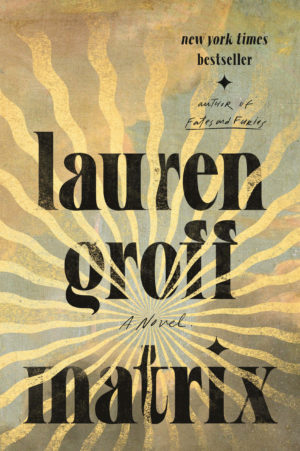Matrix
by Lauren Groff
reviewed by Bailey Sincox
Lauren Groff’s 2015 novel Fates and Furies—a finalist for the National Book Award, among other honors—is ostensibly about a marriage, but on closer inspection it’s about something thornier, unsettling in its very banality: the difficulty of knowing another person at all. Like Fates and Furies, Groff’s new novel, Matrix, is full of surprises. Its premise is simple: the life of a medieval nun, the story of a rebellious teenager’s transformation into a respected spiritual leader. However, this plot synopsis does not do justice to the whimsy, empathy, and urgency that saturate the novel’s pages.
We meet Marie, the half-acknowledged half-sister of King Henry II, as she is departing for the abbey where she will spend the rest of her life. She leaves behind not just the glamorous English court, but also her love: Eleanor of Aquitaine, the most powerful woman in the world, Henry’s wife. Over the next six decades, Marie relinquishes her grip on one kind of happiness (Westminster, Eleanor) to catch hold of another (her work, the hundreds of women who depend on it). When Marie arrives, the abbey is “a dark and strange and piteous place” where society’s discarded daughters succumb to starvation and disease. At her death, it is a thriving, self-sufficient community comprising not only nuns, but also wealthy widows flocking there for retirement and girls studying in its schools. “Of her own mind and hands, she has shifted the world. She has made something new,” Groff writes.
If this is historical fiction, it is more Sexing the Cherry (Jeanette Winterson) or How Much of These Hills Is Gold (C Pam Zhang) than Wolf Hall (Hilary Mantel). Winterson’s Renaissance London features witchcraft, time travel, and princesses dancing in the sky; Zhang tells the story of the California Gold Rush through the lens of Chinese-American orphans and the ghosts who haunt them. Like these works, Matrix takes historical specificity seriously but eschews historical realism. Groff incorporates fantastic elements, including Marie’s dream visions: rose petals carve a labyrinth through the forest; trees bear naked women instead of fruit; “the first matrix” Eve kisses Mary the “salvatrix” “with the kiss of her mouth.” Marie comes from “a famous family of viragoes … those loud opinionated unnatural women talking over each other, arguing, drawing blood, learning the battleaxe, so strange and so uncouth.” Like Winterson and Zhang, Groff queers history: some of the nuns are lovers, while others visit the “infirmatrix” for the “expression of humors” with her “expert hands.” Marie’s poems are “a blazing arrow toward her love” Eleanor, not Henry; Eleanor and Marie tacitly agree they “must be friends at a distance.” Rather than rewrite medieval history, Groff changes the way we think about it—much the way that Madeline Miller’s Song of Achilles and Circe have changed the way we think about Homer’s epics.
With a sure hand, Groff shows us Marie’s abbey as a utopia, expanding on themes in her novel Arcadia (2011), the story of a failed hippie commune. The abbey is a woman- and nonbinary-centered “second Eden.” Female artisans train apprentices in every trade. Women are fed, clothed, and sheltered from cradle to grave. They are powerful, respected, and free from bodily harm. Groff describes the nuns’ daily labor with loving, imagistic specificity: a surly, tender-hearted sister carries a stillborn calf on her shoulders “from the distraught bellowing heifer,” while a non-neurotypical nun “is quite excellent at shelling peas.” Groff doesn’t gloss over this haven’s environmental toll, describing the “families of squirrels, of dormice, of voles, of badgers, of stoats who have been chased in confusion from their homes,” and “the willow warbler [that has] vanished in panic from these lands for the time being” because of Marie’s construction projects—a continuation of Groff’s focus on the natural world in Florida (2018). Even so, Matrix offers up an alternative utopian history. What if a utopia like Marie’s had been allowed to flourish? Matrix makes us nostalgic for this past, one we never had.
Because Groff is not a biographer, anyone hoping for a life of Marie de France that traces the origins of the Lais will be disappointed. Matrix spends far more time on mystic literature drawn from the works of Julian of Norwich and others than on the romantic works for which “Marie” is known. But here is a novel where Groff is at the height of her powers, writing with honesty and conviction about what it means to make a meaningful life. Matrix, which has already been longlisted for the 2021 National Book Award for Fiction, is not to be missed.
Published on November 17, 2021

